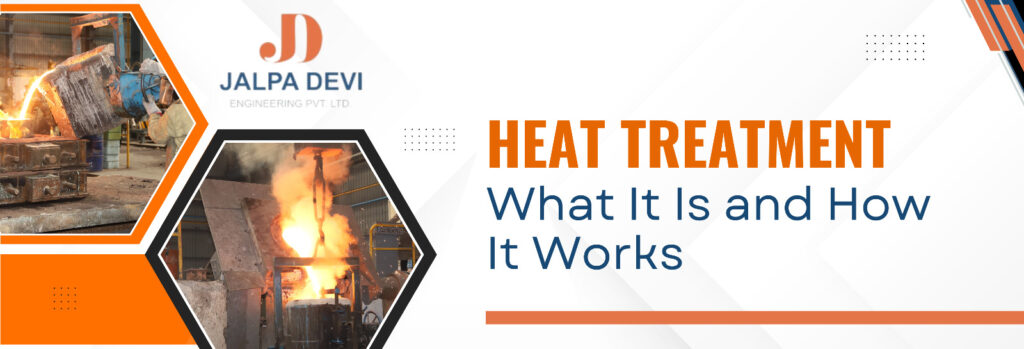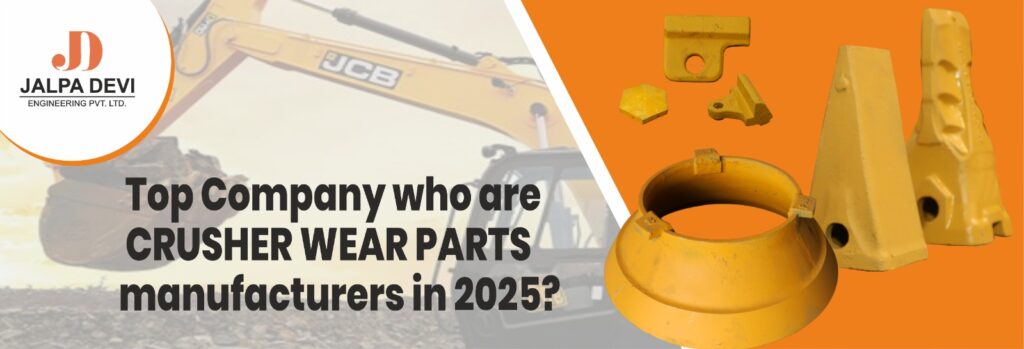Introduction
Within the subject of fabrication and metallurgy, Heat Treatment plays a fairly important role in the performance, durability, and strength of metals and alloys due to the controlled heating and cooling operations.
This blog aims to provide a basic explanation and understanding of Heat Treatment, along with how it works, the types, applications, and importance in industrial and engineering contexts. Hence, if you are an aspiring engineering student, manufacturer, or working engineer, this will lay down a solid foundation for you!
What Is Heat Treatment?
Heat Treatment is a thermal process applied on materials (generally metals) in order to change the physical properties and sometimes even the chemical properties, to it being hard, tough, or otherwise ductile and resistant to wear.
The metals are heated to a definite temperature, kept at that temperature for some time, and then cooled down under special conditions, so as to induce the desired mechanical properties and microstructure.
It basically acts to make the product perform better, gives it a longer service life, and makes the metals workable by machining, welding, or other manufacturing operations without failure under stress.
Why Heat Treatment Is Important
Heat Treatment is the internal structuring of metals such that the desired attributes like strength, malleability, or wear resistance, depending upon the application and industrial requirements, can be achieved.
In the absence of Heat Treatments, metals would generally be unsuitable for engineering uses- either being too brittle or too soft- and would cause premature failures or inefficiencies in machines and equipment of importance in industries.
The metals that have been treated would be better hereunder and capable of sustaining loads, repeated stresses, extreme temperatures, and even corrosive environments, thereby ensuring long-lasting performance.
How Heat Treatment Works
A Heat Treatment procedure usually involves three steps: controlled heating, soaking/holding at temperature, and cooling down at a controllable rate to modify the internal microstructure of a material.
Heating rearranges the atomic structure of metals, soaking makes the phase transformation uniform, and cooling determines the final grain structure, strength, hardness of the treated metal.
Depending on whether it is air-cooled, oil-quenched, or water-quenched, the rate of cooling of the metal may bring about certain hardness, brittleness, or other mechanical properties through Heat Treatment.
Key Objectives of Heat Treatment
Heat treatment also serves to increase mechanical strength, enhance hardness, and reduce internal stresses, to name a few; it also promotes fine grain structure so that the metal achieves great stability for manufacturing and application use.
Heat Treatment further promotes corrosion resistance, surface hardness, and machinability of materials, thereby allowing them to be formed, bent, or welded without cracks or distortion.
Specific objectives will depend upon what is being heat-treated, its composition, and end-use application, all of which thus lay down which particular Heat Treatment process would be adopted for particular improvements and property enhancements.
Stages of Heat Treatment
1. Heating
In this particular stage, the metal is heated to a certain temperature to begin microstructural changes. A uniform heating is essential to prevent thermal stresses or uneven transformations in the material.
2. Soaking (Holding Time)
The sample is held for the calculated time at the desired temperature to provide the complete internal transformation process and equilibrium temperature uniformly inside the material.
3. Cooling
Cooling will determine the microstructure. Rapid cooling tends to harden the microstructure, while slow cooling will soften it. The heat treatment outcome depends on the rate of cooling and the cooling medium used.
Types of Heat Treatment Processes
Each Heat Treatment type targets specific improvements in metal behavior. Here are the most commonly used processes across manufacturing and engineering industries worldwide:
1. Annealing
In general, annealing is the term for an operation in metallurgy that constitutes heating of metal and slow cooling, normally inside a furnace, so as to soften it and better its ductility for machining, bending, or cold working.
During annealing, metals lose the internal stresses they once had, grain structures get refined, and restored is lost ductility commonly caused by mechanical processes before, such as rolling or drawing during manufacture.
When a metal is annealed, it becomes workable and is quite resistant to cracking when subjected to fabrication or forming operations, which hold true for wire, sheet, and structural materials alike.
2. Normalizing
The metal is heated above a critical temperature and then cooled in still air to normalize the material. Such treatment gives rise to a refined grain size and an even distribution of improved mechanical properties throughout the metal.
The other important purpose is to gain uniformity of structure and relieve internal stresses induced during forging, welding, or casting, before machining or further assembly.
After carrying out the normalizing process, the metals become tough and dimensionally stable, which can then be used as shafts, rods, castings, or heavy structural components undergoing high load applications.
3. Hardening
Hardening involves heating the metal and quickly cooling it in water, oil, or brine to augment the hardness of the metal surface and its wear resistance, mainly for high-carbon and tool steels.
This process transforms the microstructure of the metal into a hard phase, such as martensite, thereby imparting greater resistance to wear, deformation, and abrasive environments.
It is used to harden the surface of tools and dies, hammers, and machine parts to have a suitably tough surface, but it must be further tempered to decrease brittleness and to avoid cracking.
4. Tempering
Hardening involves heating metals to certain temperatures and rapidly cooling them by quenching in water, oil, brine, or other media, depending on surface hardness and wear resistance qualities to be developed. It is typically done on high-carbon steel and tool steel.
This process converts the metal structure into a hard phase like martensite with a level of hardness greatly resisting wear, deformation, or abrasive environments.
Nonetheless, this is why it is used in producing tools, dies, hammers, and machinery parts whose tough outer surface shall need tempering to remove brittleness and prevent cracking.
5. Case Hardening
Tempering is performed after hardening to decrease the brittleness and enhance softness. The metal is reheated to a rather low degree and then slowly cooled to permit improvement in ductility without substantial reduction in hardness.
This stage also relieves stresses built up during quenching, as well as resisting impact, fatigue, and sudden shock loading encountered in actual usage.
Tempered components are used where yet a degree of softening with strength is required, hence the long-acting and dependable performance under stresses such as springs, blades, and gears.
6. Stress Relieving
The metal is heated to a moderate temperature and slowly cooled by the stress relieving process to free it of residual stresses induced by welding, machining, or forming without considering any significant phase change.
This prevents distortion, cracking, and dimensional instability in components, such as precision tools and molds and heavy welded components used in industrial applications.
It serves to increase the working life and the reliability of the components subjected to thermal or mechanical stress cycles that may produce some unusual fatigue or failure in service.
Factors Affecting Heat Treatment
1. Material Composition
Different metals have different behaviors when it comes to Heat Treatment. Hardening carbon steel is easy, but aluminum needs different treatments, such as solution heat treating, to undergo changes in properties.
2. Heating Rate and Temperature
The temperature of heating should correspond to the type of metal used and the transformation to be achieved. If improper temperatures are used, they could cause grain coarsening or oxidation and more importantly, inhibit complete transformations thereby reducing efficiency.
3. Soaking Time
If one doesn’t soak for the right time, it will affect the microstructure. Proper soaking ensures the complete transformation of the material and makes it uniform throughout the cross-section.
4. Cooling Method
Rapid cooling causes hardness but creates brittleness, while slow cooling results in softer and more ductile structures. The choice of cooling medium shall be very critical as it greatly impacts the end result.
5. Atmosphere Control
Protective atmospheres (vacuum, nitrogen, argon) prevent oxidation, decarburization, and contamination, especially in high-precision, high-alloy type components, that require clean surfaces after Heat Treatment.
Applications of Heat Treatment
1. Automotive Industry
Heat Treatment is given to engine components, gears, axles, and suspension parts to improve their fatigue strength and wear resistance so that they perform well under high speeds and heavy load conditions.
2. Aerospace Sector
Parts for aircraft such as landing gears, turbine blades, and structural components are subjected to Heat Treatment so as to obtain high strength-to-weight ratio and resistance to extreme temperature variations in flight.
3. Construction and Infrastructure
Heat Treatment imparts toughness to steel rebars and structural beams and the ability to withstand loads on welded joints so they can be incorporated safely and stably in buildings, bridges, and heavy infrastructure projects.
4. Tool and Die Manufacturing
Heat Treatment hardens and tempers drill bits, molds, cutting tools, and dies for increased edge retention and wear resistance, assuring long service life for these tools during prolonged machining operations.
5. Mining and Crushing Industry
Blow bars, hammers, liners, and jaw plates of wear-resistant parts are Heat Treated in order to resist incessant abrasion, impact, and harsh operating conditions within crushers and mills.
Advantages of Heat Treatment
- Mechanical properties that improve strength, toughness, and hardness allow components to stay in service longer under high load applications such as mines/heavy machinery.
- Wear resistance will resist surfaces from friction, abrasion, and erosion; thus, it includes low maintenance and downtimes for means and systems.
- Greater ductility and machinability create materials that simplify their forming, bending, or machining processes, thus raising production efficiency and reducing tool wear and rejection rates.
- Internal stresses are lowered, and warping during or after machining is avoided to ensure dimensional stability in parts very critical in dimensional accuracy.
- The Heat Treatment processes are combined to configure properties suited to specific applications.
Challenges in Heat Treatment
- Distortion and cracking may take place due to improper cooling or thermal shocks. Such unwanted outcomes in the high-precision parts require strict control and simulation.
- Heat Treatment incurs heavy energy consumption owing to prolonged hours of heating cycles and furnace operation. If efficiency and batch size are not optimized, it would hence turn into a very costly process.
- Oxidation and scaling stand to take place in unprotected atmospheres, especially in carbon steel. Thus, special atmospheres ought to be used either for bright Heat Treatment or clean surfaces.
- Process complexity demands the need for a skilled operator and precise instrumentation with quality checks to ascertain the outcome can be repeated between different batches and parts.
Conclusion
Heat Treatment is a primary operation in the metalworking industry, allowing materials to be modified or given specific characteristics, such as strength, hardness, flexibility, and wear resistance. This method finds a wide range of applications in sectors.
Heat Treatment makes the components sturdy enough to bear extreme conditions without failures-upholding quality, which means durability and reliability engineering standards-all across mining and aerospace industries.
A thorough understanding of Heat Treatment-the principles, processes, and outcomes-is a major concern for industries that want to develop the performance of their products and cut down failure rates while upholding the most stringent specifications.


